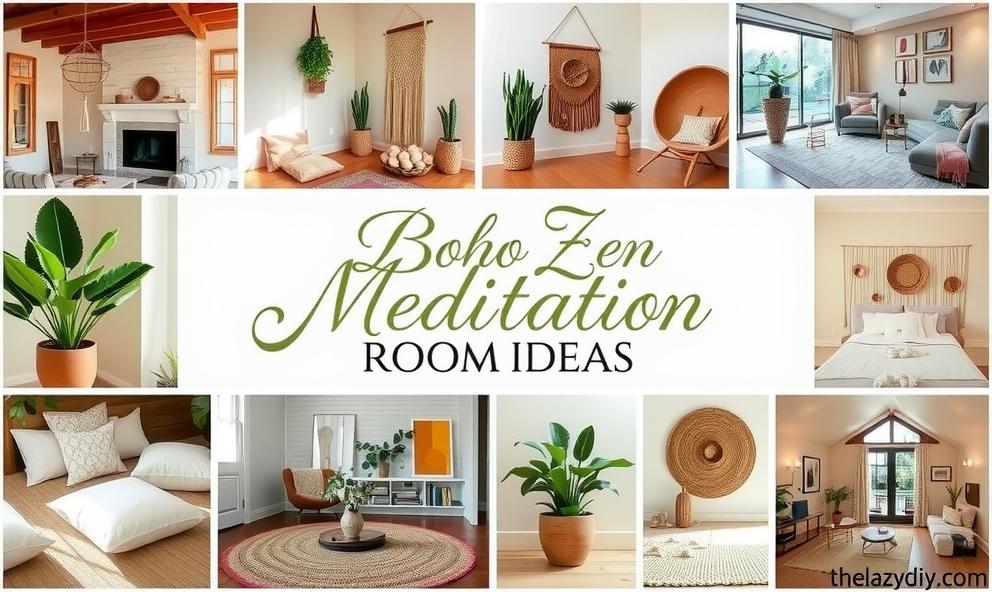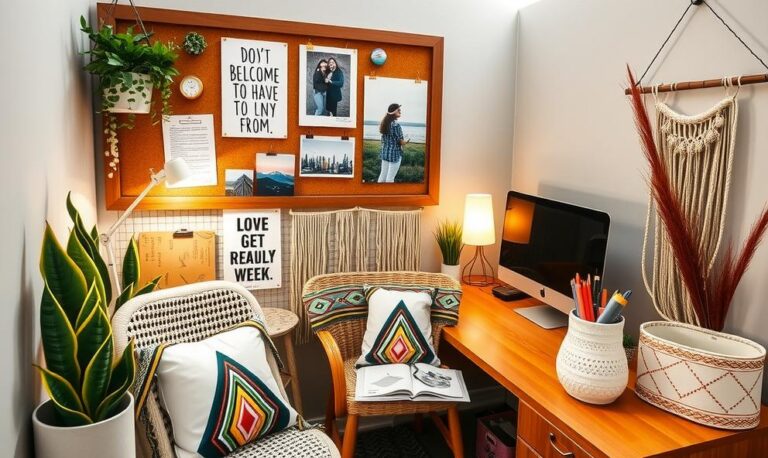Creating a Boho Zen meditation room is a wonderful way to find peace at home. This style combines the free spirit of bohemian design with the calm of Zen.
In such a space, you can unwind and meditate easily. Soft textures and earthy tones help create a soothing environment.
Incorporate natural elements like plants and stones for added tranquility. These elements connect you with nature and enhance relaxation.
Add comfortable cushions and soft rugs to complete the look. These features invite you to sit back, relax, and focus on your inner peace.
26 Boho Zen Meditation Room Ideas
Natural Light Enhancement
Maximizing natural light in a meditation room creates a serene atmosphere. Large windows adorned with sheer curtains allow soft sunlight to filter in, helping to elevate your mood.
Using mirrors strategically can reflect light and create a sense of openness. This approach helps to enhance the overall calming ambiance of the space.

Earthy Color Palette
A soothing earthy color palette incorporates shades of green, brown, and beige. These colors evoke a sense of connection to nature and promote a peaceful environment.
Consider using plant-inspired accents to maintain a harmonious look. Soft colors on the walls can complement natural furniture, enhancing the overall aesthetic.

Cozy Floor Cushions
Incorporate large, plush floor cushions for a comfortable seating option. They encourage relaxation and can be easily moved to suit your meditation practice.
Choosing cushions in bohemian prints or earthy tones adds a touch of style while maintaining comfort. Layering cushions creates an intimate and inviting space.

Indoor Plants
Adding indoor plants can purify the air and enhance the room’s tranquility. Varieties such as snake plants or peace lilies are low-maintenance options.
These green elements also connect the meditation space to nature, serving as a calming visual focus. Arranging plants in different heights creates depth and interest.

Aromatherapy Station
A dedicated aromatherapy station can elevate your meditation experience. Incorporate essential oils, candles, or diffusers to create a soothing fragrance.
Scents like lavender or sandalwood are particularly conducive to relaxation. This tactile element can deepen your focus and enhance overall serenity.

Minimalist Design
Emphasizing a minimalist design aids in decluttering both the mind and space. Fewer distractions allow for deeper meditation and mindfulness practice.
Opt for simple yet functional furniture that serves a purpose. An uncluttered environment can significantly contribute to a sense of calm.

Inspirational Wall Art
Inspirational wall art can serve as a focal point and motivate your practice. Consider peaceful landscapes or mindfulness quotes to enhance the meditative atmosphere.
Choose artwork that resonates with your personal philosophy. This personal touch imparts deeper meaning and connection within the space.

Soft Lighting Options
Soft lighting can create an inviting and warm environment perfect for meditation. Using dimmable lamps or fairy lights encourages relaxation during your sessions.
Avoid harsh overhead lights that can be distracting. Instead, embrace a variety of light sources that promote a cozy ambiance.

Meditation Altar
A meditation altar serves as a sacred space for personal reflection. Incorporate meaningful items such as crystals, candles, and photographs.
This personal touch transforms the area into a sanctuary of peace and intention. It allows practitioners to connect on a deeper level with their practice.

Textured Wall Elements
Textured wall elements can add depth to your meditation room. Consider incorporating wooden panels or woven wall hangings for a bohemian touch.
Such textures create a tactile experience that enhances the overall aesthetic. They can also help in sound absorption, fostering a peaceful environment.

Cozy Blankets and Throws
Providing cozy blankets and throws can make the space feel inviting and safe. They are perfect for a quick wrap during meditative practices.
Choose textiles that complement the color scheme and boost the room’s warmth. This simple addition makes the space feel even more comforting.

Grounding Elements
Incorporate grounding elements like crystals, stones, or driftwood into your decor. These natural materials reinforce the connection to earth and promote stability.
Arranging them thoughtfully can create visual interest while supporting a calming vibe. They can also serve as focal points during meditation.

Customizable Space
Design your meditation room to be easily customizable to accommodate changing needs. Flexibility in arrangement can personalize your experience further.
Moving furniture or decor can brighten your mood and keep your practice fresh. This adaptability contributes to keeping your meditation journey lively.

Natural Fiber Rugs
Opt for rugs made from natural fibers such as jute or cotton. These materials enhance comfort while promoting a bohemian aesthetic in your meditation room.
A thoughtfully placed rug can also define areas for practice and encourage relaxation. Choose textures that are gentle underfoot, fostering a sense of calm during meditation.

Sound Elements
Integrate soft sound elements like wind chimes or a gentle water fountain. These features can create a tranquil soundscape that supports meditative practices.
Gentle background sounds can help mask distractions and promote deep focus. They can also enhance the feelings of being connected to nature.

Sensory Features
Engage all five senses for a more fulfilling meditation experience. This can include textured elements, soothing scents, and calming sounds.
This multi-sensory approach deepens your relaxation and mindfulness. It encourages you to immerse fully in each moment of your practice.

Personal Touches
Add personal touches that reflect your unique personality and journey. This could include photos, favorite books, or handwritten affirmations.
Personalizing your space fosters a deeper connection to your meditation practice. It transforms the area into a true sanctuary for the soul.

Nature-Inspired Themes
Nature-inspired themes can further enhance your meditation experience. Elements such as wood, stone, and plants evoke a sense of peace and tranquility.
Such themes not only connect you to nature but also create a calming environment for meditation. Consider incorporating earthy textures and colors in your decor.

Interactive Spaces
Design areas in your meditation room that encourage interactive practices like yoga. Combining meditation with movement creates a holistic experience.
This flexibility allows you to explore different forms of mindfulness. It aids in both mental and physical relaxation, enriching your overall journey.

Board of Intentions
Create a board of intentions where you can display your goals and aspirations. This constant visual reminder keeps you aligned with your purpose during meditation.
It also cultivates a sense of accountability and motivation for your practice. This unique addition personalizes your meditation experience significantly.




